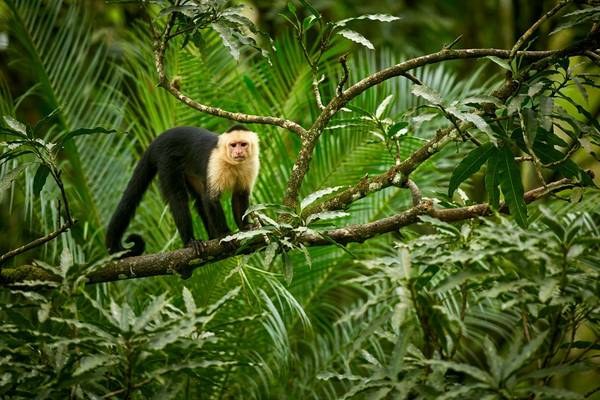The Wildlife of Central America






Central America is rightly considered one of the world’s best areas for wildlife. Despite its relatively tiny size – a small, tapering strip of land, dwarfed by the two continents it connects – the region contains some of the greatest concentrations of biodiversity on Earth. Bordering Mexico to the north and Colombia to the south, the seven Central American countries collectively offer an unrivalled set of natural history experiences. Although Costa Rica and Panama are probably the most famous, and certainly the most popular, wildlife destinations in the region, they are far from the only worthwhile nations to visit. In particular, Honduras, Guatemala and Belize provide the best of both worlds – an opportunity to leave the beaten tourist track, while also encountering many of the region’s most iconic species.
Speak with our Central America specialist

Our Specialist Recommends
Operations Manager - Andy TuckerThe Wildlife of Central America
Nowhere exemplifies this better than Honduras. Approximately the size of England, the country is dotted with over 100 protected areas, ranging from coastal mangroves and expansive wetlands to lowland rainforest and arid thorn scrub forest. Despite the extraordinary diversity on offer, the country receives so few wildlife travellers that groups often have entire national parks to themselves. Of all Honduras’ reserves, it is perhaps the area around the Pico Bonito National Park that provides the most rewarding experience. Here, visitors can stay in the comfortable Lodge at Pico Bonito, which gives ideal access to the area’s wildlife, including over 400 species of bird. As well as the national park, the lodge is situated close to several other remarkable protected areas, which collectively highlight Honduras’ extraordinary variety of landscapes and habitats.
The lodge has its own 400-acre reserve bordering the park, along with three beautifully constructed observation towers, ensuring eye-level views of canopy-dwelling creatures such as the sought-after Lovely Cotinga. Other species that can be encountered in this patchwork of tropical, secondary and gallery forests include Keel-billed Motmot, Masked Tityra, Ferruginous Pygmy Owl, Slaty-tailed Trogon and up to 16 dazzling varieties of hummingbird. White-collared and Red-capped Manakins also occur here, and many raptor species including White Hawk and Ornate Hawk-Eagle can be observed from passes overlooking the Rio Coloradito.
Further south, pockets of tropical dry forest provide the habitat for Honduras’ only endemic bird: the Honduran Emerald. This stunning hummingbird, while critically endangered, is common within its surviving habitat, which it shares with such desirable birds as Double-striped Thick-knee, Lesser Roadrunner, White-throated Magpie Jay and Banded Wren.
Another productive site close to the Pico Bonito National Park is the Cuero y Salado Wildlife Refuge, a 35,000-acre swathe of rivers, lagoons, mangroves and forests that contains a distinctive set of wild animals. Access to the reserve is initially via a small train, which passes marshes where Wood Stork, White-tailed Kite and Mangrove Cuckoo thrive. Within the core of the protected area, exploration is conducted by boat – cruising the network of channels can provide sightings of birds like Agami and Boat-billed Herons, Jabiru Stork, Pygmy Kingfisher, Sungrebe and many more, alongside mammals such as Mantled Howler Monkey, White-faced Capuchin and Northern Tamandua. American Crocodile is abundant, Blue Morpho butterflies flutter overhead, and with luck the elusive West Indian Manatee may be encountered.
Cuero y Salado is just one of many wonderful wildlife-watching destinations in Honduras. The country may lack the overall diversity of Costa Rica or Panama, but few other countries offer similarly easy access to such a wide variety of habitats – all the locations described above are within a 30-minute drive of The Lodge at Pico Bonito.
Honduras’ western neighbour, Guatemala, is another under-visited gem. As well as fabulous wildlife, it is also home to the core of the ancient Maya civilisation, which collapsed around a thousand years ago. The country contains one of the largest undisturbed tracts of rainforest in Central America, and its avifauna in particular is sure to impress even the most seasoned birdwatcher. Pleasingly, much of the country’s diversity can be explored from comfortable country houses (known as ‘fincas’), which invariably have friendly staff, wildlife-rich grounds and delightful accommodation.
One of the most thrilling destinations in Guatemala is the Atitlan Important Bird Area, which covers a wide altitudinal range around the slopes of the Atitlan Volcano. Contained within the protected area are Atitlan Lake, once home to the now-extinct Atitlan Grebe, and the San Pedro Volcano, near whose summit can be seen the spectacular Horned Guan. The nearby Los Andes Reserve is additionally home to globally threatened and regionally endemic birds such as Highland Guan, Azure-rumped Tanager and Pink-headed Warbler.
Amongst the major Maya archaeological sites is the complex of Yaxha, which is surrounded by lush lowland rainforest – standing at dusk on its solstice observatory, visitors can watch as great flocks of Red-lored, White-fronted and White-crowned Parrots fly to their night-time roosts. Yaxha may be spectacular, but it pales in comparison to Tikal, the most magnificent of all Central America’s Maya ruins. The towering ancient pyramids and mysterious tombs hold immense appeal on their own, but amongst them can also be seen a marvellous assortment of special birds, including Ocellated Turkey and Pheasant Cuckoo. The general diversity is almost overwhelming, with myriad neotropical flycatchers, hummingbirds, euphonias and honeybirds to be found, along with Yucatan Black Howler Monkey and White-nosed Coati.
Tikal is located in northern Guatemala, not far from the border with Belize. Visitors to this small Caribbean-coast nation, which only became independent from Britain in 1981, often travel into Guatemala to see the ruins, but Belize contains its own equally fascinating archaeological and natural wonders. These include the Maya city of Caracol, the main pyramid of which is still the largest building ever constructed in the country. Belize is also a superb wildlife destination in its own right, offering easy access to a wide range of habitats. One such location, close to Belize City, is the village of Burrell Boom, which provides opportunities to locate classic species such as Vermillion Flycatcher, Orchard Oriole, Common Tody Flycatcher and Grey-necked Wood Rail; there is also a thriving population of Yucatan Black Howler Monkeys in the nearby Community ‘Baboon’ Sanctuary, which has successfully protected these beautiful primates since the 1980s.
Another important area is the Crooked Tree Wildlife Sanctuary, established in 1984 to protect the huge concentrations of wetland birds that arrive here in the dry season. Amongst the maze of lagoons, swamps and waterways can be found Black-bellied Whistling Duck, Snail Kite, Bare-throated Tiger Heron, all five neotropical kingfishers and an impressive array of herons and egrets. Excursions by boat can additionally turn up Jabiru Stork, Roseate Spoonbill, Anhinga, Limpkin and Sungrebe, as well as Morelet’s Crocodile and several species of freshwater turtle and iguana. Away from the waters, native pine forests support Ladder-backed Woodpecker, Mangrove Vireo and Yellow-billed Cacique, and local endemics such as Yucatan Jay and Yucatan Squirrel.
Just a short 45-minute drive from Crooked Tree is the small town of Orange Walk, gateway to one of Belize’s best-kept secrets. From here, a speedboat whisks visitors along narrow, tree-lined channels deep into the forests, and to the isolated Maya site of Lamanai. Like Tikal, Lamanai is surrounded by pristine jungle, bursting with chachalacas, toucans and parrots, while smaller areas of secondary growth contain the attractive Black-throated Bobwhite. There are also patches of pine savannah, which supports its own set of interesting birds, including Yellow-headed Parrot, Azure-crowned Hummingbird, Yucatan Flycatcher and Grey-crowned Yellowthroat. Visitors who choose to stay at the wonderfully appointed Lamanai Outpost Lodge can also venture out at night – nocturnal boat trips on the lagoons often produce Morelet’s Crocodile, Hickatee (a large river turtle), potoos and Fish-eating Bats.
It is not just Belize’s freshwater habitats that are rich; its Caribbean waters also abound with marine-life, and a sprinkling of small islands (known as ‘cayes’) are perfect bases for underwater exploration. One of the sought-after species here is the West Indian Manatee, which can be seen close to some of the world’s most dazzling coral reefs. Snorkelling often brings encounters with a bewildering kaleidoscope of species, including Blue Tang, Trumpet Fish and Queen Trigger Fish, alongside lobsters and sea cucumbers. Although the wildlife will always be diverting, the sandy, sun-drenched shores and luxurious beach resorts can also provide the perfect restful end to any Central American nature holiday.
Costa Rica and Panama may steal the Central American headlines, but there is far more to this megadiverse region than those two countries alone. For travellers who wish to experience remarkable neotropical wildlife and an astonishing variety of landscapes away from most other tourists, a visit to Honduras, Guatemala or Belize will prove immensely rewarding.



 Loading search...
Loading search...



















